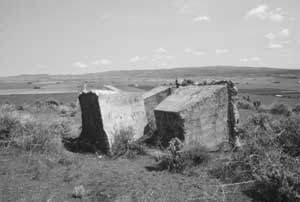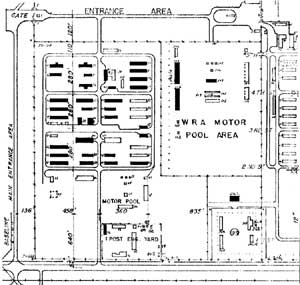MENU
|
| |
Confinement and Ethnicity: An Overview of World War II Japanese American Relocation Sites by J. Burton, M. Farrell, F. Lord, and R. Lord |

|
|
| |
Chapter 13 (continued)
Tule Lake Relocation Center
Security Features
 Figure 13.45. Watch tower foundation blocks at Tule Lake. |
 Figure 13.54. World War II-era buildings remaining in the military police compound. (click image for larger size (~84K) ) |
East of the military police compound the jail still stands, abandoned. The jail, within a Caltrans maintenance yard and surrounded by a fence with a locked gate, was documented in 1989 by the Historic American Building Survey (HABS Number CA-2279). No remains of the adjacent stockade are apparent.
The one-story concrete jail is made of steel-reinforced concrete walls and a similar flat concrete roof (Figures 13.61 and 13.62). There are six identical cells in the building, four against the northwest wall and two against the southeast wall. Each cell had six bunks, a toilet and a wash basin (Figure 13.63). There is no evidence of electricity in each cell, but the building was wired. Apparently a single cast-iron coal burning stove in the entrance room heated the entire building (Figure 13.64).
There are numerous pencilled inscriptions on the jail cell walls. Many are simply doodles, but others include names, dates, and political statements. Some are in Japanese and some are in English (Table 13.2; Figures 13.65-13.66, cover art). It is apparent that in some cases the writer was lying on his bunk since the writing is 90 degrees from the horizontal.
Table 13.2. Selected Pencilled Inscriptions on the Walls of the Stockade Jail.
| Japanese | "The Great Japanese Empire" (dai nippon teikoku) and the word "window" | Figure 13.65 | |
| Japanese | "Down with the United States" | cover art | |
| Japanese | "Yoshida" (surname) | ||
| Japanese | Three times the ideogram for "tadashii;" this is a Japanese/Chinese, way of counting off, as Americans use 1111 and then a diagonal line; the character has five strokes, so a complete character (all of these are complete) counts off "5" | ||
| Japanese | Right portion of left set reads: "Kaishaku wo tanomu,
meaning "Please he a second when I commit Harakiri." Left portion of left set reads: "Mondai no kaishaku," meaning "Interpretation of problem." Both portions use the word "kaishaku," though they have different meanings. A Chinese translator translated the right portion as "Today was wrongfully accused of disorder problem" and the left portion as "The explanation of the problem." Upper right character not clearly written but seems to be the male first name Akira; other characters in that set are illegible. |
cover art | |
| Japanese | Left column: (indistinct) Yamaguchi Terasu (a male
name, Terasu Yamaguchi) Iwakuni City (in Japan), the last character is
"vehicle "which does not seem to fit, or if badly written, Ô"east") Middle column: Kono (or Kawano) Toshisen (a male name, Toshisen Kono or Kawano) 1919 (one more character, illegible) Right column: September 29, 1945 |
Figure 13.66 | |
| Japanese | Graffiti with parts of names and words in hiragana (one of the Japanese phonetic systems); legible characters include "center," "loyalty," and "useful lecture" (story, information) | ||
| English | When the golden sun has sunk beyound the desert horizon and darkness followed, under a dim light casting my lonesome heart | ||
| English | Show me the way to go to home | cover art | |
| English | Large "5" | English |
|
English | H.T. 5/25/45 MON. |
cover art |
 Top
Top
Last Modified: Fri, Sep 1 2000 07:08:48 pm PDT
http://www.cr.nps.gov/history/online_books/anthropology74/ce13j.htm
![]()


